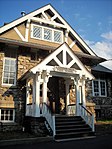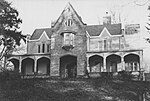Old Albany Post Road

Old Albany Post Road is a 6.6-mile (10.6 km) dirt road in Philipstown, New York, one of the oldest unpaved roads still in use in the United States. It runs mostly north-south through the southeastern corner of the town, near the Putnam Valley town line. Starting from an intersection with Sprout Brook Road at Continental Village just north of the Putnam-Westchester county line, it ends at an oblique junction with US 9 east of Garrison. As the least improved section of the original Albany Post Road, it was added to the National Register of Historic Places (NRHP) in 1982. Its history as a formal road dates to the mid-17th century, when it was built on established Native American trails. Later it would see military use, particularly by the Continental Army during the Revolution, and commercial use as part of a stagecoach route. Some of the milestones placed during the early years of American independence to more accurately calculate postal rates are still present and have been preserved and restored. It is still in public use and maintained by the town. The town has recently angered some of the residents by proposing to pave the road.
Excerpt from the Wikipedia article Old Albany Post Road (License: CC BY-SA 3.0, Authors, Images).Old Albany Post Road
Old Albany Post Road,
Geographical coordinates (GPS) Address Nearby Places Show on map
Geographical coordinates (GPS)
| Latitude | Longitude |
|---|---|
| N 41.375277777778 ° | E -73.897222222222 ° |
Address
Old Albany Post Road 502
10524
New York, United States
Open on Google Maps







